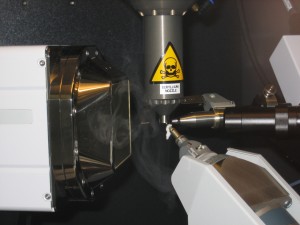Doubted molecular structure confirmed

FAU chemists’ insights solve long-running debate
A cross with a tiny sphere in the middle and four outstretched arms: a simplified way of depicting a carbon atom. In their first year of chemistry, students learn from this model that all such atoms can form no more than four bonds. This is undoubtedly true for the conventional particles that have been known for a long time.
However, there have been discussions about particularly reactive carbon compounds with what is known as a non-classical structure that can form five or even more bonds. At the x-ray laboratory of FAU’s Department of Inorganic and General Chemistry, the crystallographic analysis of the prototype of such a non-classical carbocation has now been accomplished. On Friday, 05 July 2013, the journal Science published these ground-breaking findings of physical chemistry.*)
The structure of the organic molecule known to chemists as 2-norbornyl cation had been the subject of fierce debate throughout the second half of the twentieth century. Leading scientists such as George A. Olah and Herbert C. Brown, both US chemists and recipients of the Nobel Prize in Chemistry (Brown, 1979 and Olah, 1994), fought publicly and with great vehemence about whether non-classical ions should be depicted as having a symmetrical structure. Paul von Ragué Schleyer, professor of Organic Chemistry at FAU until 1998, voiced his support for the non-classical approach.
The controversial 2-norbornyl molecules are ions with a positive electric charge (cations). Their surprisingly high reactivity made it seem plausible that these cations had a non-classical structure. However, the molecule’s necessary symmetry could never be proven conclusively. While numerous pieces of evidence to support the symmetrical, non-classical structure were gathered over the years, irrefutable proof of this structure had been missing so far.
Experts in basic research from the University of Freiburg, the University of Georgia and FAU have now overcome the last obstacles and determined the crystal structure. The Freiburg chemists led by Ingo Krossing were able to create suitable crystals of a 2-norbornyl salt and examine them with spectroscopic and theoretical methods. Numerous difficulties had to be overcome during the subsequent x-ray crystallography at the laboratory of Karsten Meyer, Chair of the Department of Inorganic and General Chemistry in Erlangen.
The crystals turned out to be stable only at low temperatures. At over -60°C, however, they were highly sensitive and extremely vulnerable to air and moisture. This sensitivity of 2-norbornyl systems is connected with a dynamic inherent to the molecule and probably thwarted many previous attempts at determining their structure.
The molecules were only found to have a well-ordered form at negative temperatures that cannot be attained with the nitrogen cooling generally used in modern x-ray laboratories. The stabilisation process started at -187°C. The helium-cooled single-crystal diffractometer at the Erlangen laboratory allowed for x-ray measurements of several crystals at -233°C, 40 degrees above absolute zero. The researchers were able to reproduce the results several times.
Unlike his opponent George Olah, the Nobel Prize recipient Herbert Brown did not live to see their dispute solved. However, the chemistry books of the future will have one answer more where there used to be a question.
*) DOI: 10.1126/science.1238849
Further information:
Prof. Dr. Karsten Meyer
Phone: +49 (0)9131 85 27360
karsten.meyer@fau.de
Dr. Frank W. Heinemann
Phone: +49 (0)9131 85 27383
frank.heinemann@fau.de